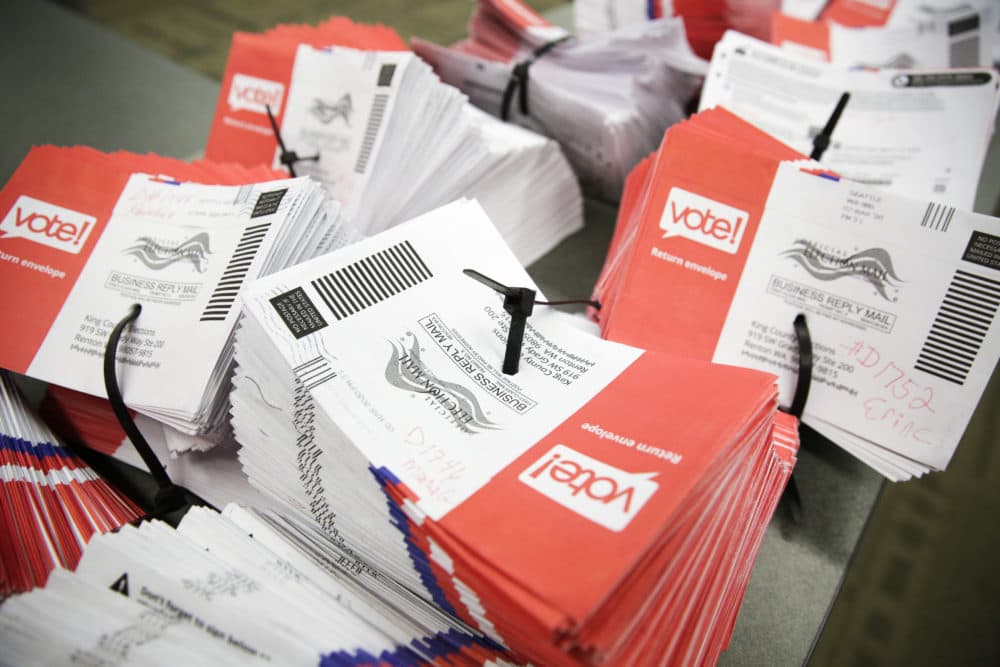Advertisement
Why Mail-In Voting Works And How To Solve Real Concerns
Resume
President Trump says mail-in voting will result in massive voter fraud interference — but experts such as Charles Stewart say there's little evidence to support this claim.
Critics say Trump and the United States Postal Service’s postmaster general are trying to slow down the postal service ahead of the election. But at the same time, Trump says he loves absentee ballots, which he and his family have used for years.
Mail-in and absentee ballots are close to the same thing, says Stewart, a political science professor at the Massachusetts Institute of Technology. Many states have changed their laws to say mail ballots instead of absentee ballots, though voters still need to apply for one.
Florida, for example, replaced all references to absentee ballots with mail ballots in its election code several years ago, he says.
Some states still require voters to provide a valid excuse for needing an absentee ballot such as an illness or traveling out of town on Election Day. States including Texas and Tennessee are facing legal challenges over this rule, he says.
Most states don’t require an excuse. This year, New Hampshire is one state that’s accepting COVID-19 concerns as a reason to vote by mail, he says.
In nine states and Washington D.C., every registered voter will receive a ballot in the mail ahead of the election. In addition, 34 states are offering mail-in voting in addition to in-person polls because of COVID-19.
Stewart has written extensively on the topic of mail-in voting and concluded — like other experts — that there's little evidence to support that mail ballots cause fraud.
The amount of voter fraud in Oregon, which has been allowing people to vote by mail the longest of any state, is small: .000004% of votes cast in the state are fraudulent. Researchers aren’t seeing hundreds or thousands of fraudulent ballots being created or returned in the five states that have long conducted a vote by mail system, he says.
“You can say a lot of things about the mail ballot system,” he says. “But one of the things you're not going to say about those states is that they're rampant with fraud.”
Across the country, the mail-in voter fraud rate is .00006% — meaning the chances of voter fraud are about five times less than getting hit by lightning in the U.S. The numbers show Trump isn’t speaking from a place of knowledge when he criticizes mail-in voting, Stewart says.
The states that have been doing mail-in voting for years recognize the opportunities for fraud and have systems in place to prevent it, he says. This includes signature matching and organized voter registration rolls.
“[States] worked up to the vote by mail system over a number of years, if not decades,” he says. “They understand that if fraud were rampant, these election systems would crumble in the public's eyes, in the eyes of the legislature.”
To efficiently prevent fraud, vote by mail states have automated signature matching. These states collect multiple signatures from voters through documents such as a driver’s license renewal to compare to their ballot, he says.
For the four states that are new to mail-in voting this election, Stewart says he’s not too concerned. Without a portfolio of voters’ signatures, states new to this system will need to match signatures manually, as New York did in its primary.
Stewart’s main concerns in these states are that legitimate voters will have their ballots rejected because their signature changes or that the counting of votes will take weeks. Policymakers and voters need to focus on these issues, he says — not Trump’s unsubstantiated critiques.
“I think we have to start with acknowledging that when you send a ballot out into the world, you are giving bad actors opportunities to act badly,” he says. “And you need to make sure that the systems are in place to catch people voting for other folks.”
Trump has also claimed that mail-in voting will disadvantage Republican candidates. Stewart says "empirically, it's just not true."
Take Florida, for example. Stewart and his research team looked at mail-in voting in the state's primary and found Republicans voted by mail at a much higher rate than Democrats.
Lawyers for the Trump campaign have been fighting in Nevada to block that state from sending ballots to all registered voters and trying to prevent Pennsylvania from using ballot drop boxes.
In states such as Oregon and Washington, the state mails out the ballots but most voters return them in person, he says. If possible, Stewart recommends voters bring their ballot to a dropbox or precinct, depending on the state’s rules.
Videos have shown mass-sorting machines being moved out of some postal offices, and some believe Postmaster General Louis DeJoy, a major donor to Trump's campaign, has been undercutting the service by moving this machinery. On CNN, Jessica Huseman, who covers the post office for ProPublica, said not to worry about the sorting machines, but rather that DeJoy is cutting back on overtime and saying mail ballots will no longer be priority mail.
The challenges the USPS faces aren’t new — not to the post office, nor state and local officials, Stewart says.
“If you want to vote by mail, you need to have a plan,” he says. “You need to request a ballot early. You need to return it early. If your state has a tracker, you need to make sure it's gotten back.”
Karyn Miller-Medzon produced and edited this interview for broadcast with Tinku Ray. Allison Hagan adapted it for the web.
This segment aired on August 17, 2020.

